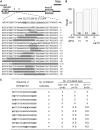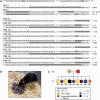Efficient generation of large-scale genome-modified mice using gRNA and CAS9 endonuclease
- PMID: 23997119
- PMCID: PMC3814358
- DOI: 10.1093/nar/gkt772
Efficient generation of large-scale genome-modified mice using gRNA and CAS9 endonuclease
Abstract
The generation of genome-modified animals is a powerful approach to analyze gene functions. The CAS9/guide RNA (gRNA) system is expected to become widely used for the efficient generation of genome-modified animals, but detailed studies on optimum conditions and availability are limited. In the present study, we attempted to generate large-scale genome-modified mice with an optimized CAS9/gRNA system, and confirmed the transmission of these mutations to the next generations. A comparison of different types of gRNA indicated that the target loci of almost all pups were modified successfully by the use of long-type gRNAs with CAS9. We showed that this system has much higher mutation efficiency and much lower off-target effect compared to zinc-finger nuclease. We propose that most of these off-target effects can be avoided by the careful control of CAS9 mRNA concentration and that the genome-modification efficiency depends rather on the gRNA concentration. Under optimized conditions, large-scale (~10 kb) genome-modified mice can be efficiently generated by modifying two loci on a single chromosome using two gRNAs at once in mouse zygotes. In addition, the normal transmission of these CAS9/gRNA-induced mutations to the next generation was confirmed. These results indicate that CAS9/gRNA system can become a highly effective tool for the generation of genome-modified animals.
Figures





References
-
- Capecchi MR. Gene targeting in mice: functional analysis of the mammalian genome for the twenty-first century. Nat. Rev. Genet. 2005;6:507–512. - PubMed
-
- Wallace HA, Marques-Kranc F, Richardson M, Luna-Crespo F, Sharpe JA, Hughes J, Wood WG, Higgs DR, Smith AJ. Manipulating the mouse genome to engineer precise functional syntenic replacements with human sequence. Cell. 2007;128:197–209. - PubMed
-
- Bhaya D, Davison M, Barrangou R. CRISPR-Cas systems in bacteria and archaea: versatile small RNAs for adaptive defense and regulation. Annu. Rev. Genet. 2011;45:273–297. - PubMed
Publication types
MeSH terms
Substances
LinkOut - more resources
Full Text Sources
Other Literature Sources
Research Materials

